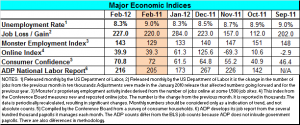Temporary workers and agency hiring helped drive a big part of February’s 227,000 new jobs, according to the report out this morning from the Bureau of Labor Statistics.
It’s the third consecutive month of job increases over 200,000, and the numbers exceeded what most economists were expecting. The unemployment rate remained at 8.3%, which is what economists expected.
Surveys conducted before the numbers were released this morning showed economists forecasting somewhere between about 210,000 and 220,000 new jobs last month. Few individual economists expected as strong a showing as this for a month of 29 days.
In addition to the February numbers, the Labor Department’s Bureau of Labor Statistics adjusted up the numbers for January and December by 61,000.
“The labor market has found its legs in the last few months,” said Julia Coronado, chief economist for North America at BNP Paribas in New York. She told MarketWatch, “it looks like there’s enough of a broad base that the momentum can be sustained.”
While the jobs gains were spread across most sectors, staffing and employment services contributed 27% of the total new hires. Temp jobs, which, along with healthcare, have been fueling much of the job growth over the last 18 months, added 45,200 new jobs to the economy.
T he growth here shows that employers are still cautious about adding permanent hires, so are turning to temps to handle the growing workload. As the economy continues to improve, labor economists predict that the temporary positions will be converted into permanent hires.
he growth here shows that employers are still cautious about adding permanent hires, so are turning to temps to handle the growing workload. As the economy continues to improve, labor economists predict that the temporary positions will be converted into permanent hires.
How much of that is likely is still anyone’s guess, as there is evidence that businesses are relying on temporary hires as part of an overall workforce strategy.
Other sectors showed even larger numbers of new workers, with healthcare’s 61,000 new hires topping the list. Hospitals added just over a third of those new healthcare jobs, with ambulatory care facilities — doctor’s offices, outpatient facilities and the like — adding 28,200 positions.
The private sector created 233,000 jobs (which was offset by 6,000 job losses in government). Only in construction, down 13,000 jobs, and retail, down 7,400, were there significant private sector losses.
In addition to the employment services area and healthcare, there were big gains in manufacturing and leisure. Leisure and hospitality jobs grew by 44,000, most of that in the restaurant industry. Manufacturing added 31,000 new positions, with slightly more than a third of the workers hired for metal fabrication jobs.
Among the biggest losers were retail jobs in department stores. Some 25,000 jobs were cut there, not unexpectedly however, as stores completed inventory. That number was counterbalanced by a nearly identical growth in retail jobs in January.
Other signs of strength were an increase in the manufacturing workweek by .1 hour to 41 hours and an increase of 3 cents per hour in the average hourly wage. It now stands at $23.31.
